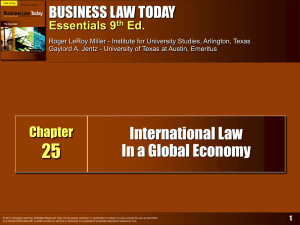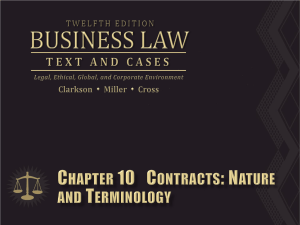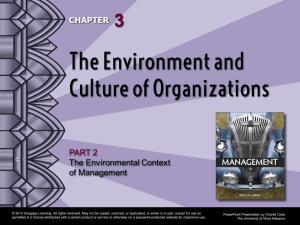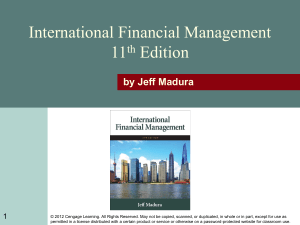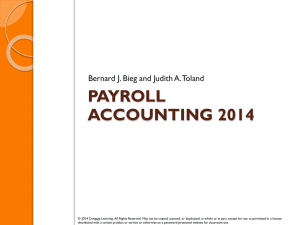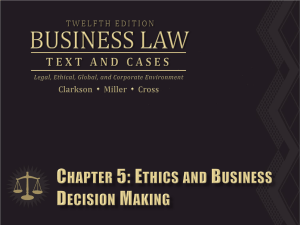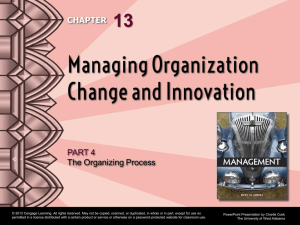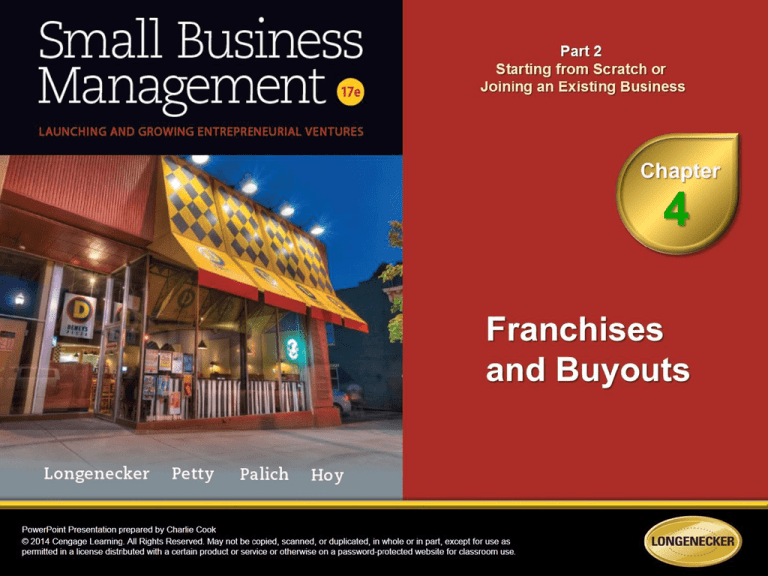
1. Define franchise, and become familiar with
franchise terminology.
2. Understand the pros and cons of franchising and
the structure of the industry.
3. Describe the process for evaluating a franchise
opportunity.
4. List four reasons for buying an existing business,
and describe the process for evaluating an existing
business.
© 2014 Cengage Learning. All Rights Reserved. May not be copied, scanned, or duplicated, in whole or in part, except for use as
permitted in a license distributed with a certain product or service or otherwise on a password-protected website for classroom use.
4–2
What Is a Franchise?
• Franchising
A business model involving a business owner who
licenses trademarks and methods to an independent
entrepreneur.
• Franchisor
Party in franchise contract that specifies methods to
be followed and terms to be met by the other party.
• Franchisee
An entrepreneur whose power is limited by a
contractual agreement with a franchising
organization.
© 2014 Cengage Learning. All Rights Reserved. May not be copied, scanned, or duplicated, in whole or in part, except for use as
permitted in a license distributed with a certain product or service or otherwise on a password-protected website for classroom use.
4–3
Franchising Terminology
• Franchise Contract
The legal agreement between franchisor and
franchisee
• Franchise
The privileges conveyed in the franchise contract
© 2014 Cengage Learning. All Rights Reserved. May not be copied, scanned, or duplicated, in whole or in part, except for use as
permitted in a license distributed with a certain product or service or otherwise on a password-protected website for classroom use.
4–4
Franchising Options
Product and trade
name franchising
Area
developers
Business format
franchising
Piggyback
franchising
Master
licensee
Types of
Franchising
Arrangements
Multiple-unit
ownership
© 2014 Cengage Learning. All Rights Reserved. May not be copied, scanned, or duplicated, in whole or in part, except for use as
permitted in a license distributed with a certain product or service or otherwise on a password-protected website for classroom use.
Multi-brand
franchising
Co-branding
4–5
4.1
Advantages of the Franchise Model
© 2014 Cengage Learning. All Rights Reserved. May not be copied, scanned, or duplicated, in whole or in part, except for use as
permitted in a license distributed with a certain product or service or otherwise on a password-protected website for classroom use.
4–6
The Pros and Cons of Franchising
• Probability of Success
• Franchise Costs
Proven line of business
Initial franchise fee
Pre-qualification of
Investment costs
franchisee
Training Support
Royalty payments
Franchisor-provided
Financial assistance
Franchisor assistance
Operating benefits
Franchisor-aided
Advertising costs
Restrictions on
business operations
Loss of independence
Lack of franchisor
support
© 2014 Cengage Learning. All Rights Reserved. May not be copied, scanned, or duplicated, in whole or in part, except for use as
permitted in a license distributed with a certain product or service or otherwise on a password-protected website for classroom use.
4–7
Concerns About Franchising
1. Misleading or exaggerated earnings claims by franchisors
2. Opportunity behavior by which the franchisor becomes a competitive threat to
franchisees
3. Restrictions on franchisees who desire to liquidate their holdings in favor of
alternative investment opportunities
4. Conflicts of interest, such as when a franchisor forces franchisees to be captive
outlets for other suppliers owned by the franchisor
5. Churning: terminating a successful franchise operation in order to resell it and gain
additional franchise fees
6. Encroachment: locating a new outlet or point of distribution too close to an existing
franchisee, causing a material loss of sales
7. Imposing noncompete clauses on franchisees
8. One-sided contracts devised by franchisors
9. The imposition of new restrictions as a requirement of contract renewal
10. Franchisor intimidation of franchisees who attempt to form franchisee associations,
seek alternative sources for products, or make other efforts to create a more level
playing field
© 2014 Cengage Learning. All Rights Reserved. May not be copied, scanned, or duplicated, in whole or in part, except for use as
permitted in a license distributed with a certain product or service or otherwise on a password-protected website for classroom use.
4–8
4.2
Profile from International Franchise Association (2012)
© 2014 Cengage Learning. All Rights Reserved. May not be copied, scanned, or duplicated, in whole or in part, except for use as
permitted in a license distributed with a certain product or service or otherwise on a password-protected website for classroom use.
4–9
Franchisor Controls on Franchisees
• Limiting sales territories
• Requiring site approval
• Imposing requirements on outlet appearance
• Limiting goods and services offered for sale
• Limiting advertising and hours of operation
© 2014 Cengage Learning. All Rights Reserved. May not be copied, scanned, or duplicated, in whole or in part, except for use as
permitted in a license distributed with a certain product or service or otherwise on a password-protected website for classroom use.
4–10
Evaluating Franchise Opportunities
• Selecting a Franchise
Personal observation
Advertisements
• Investigating the Potential Franchise
Information sources
Independent, third-party sources
– Federal Trade Commission
– Internet
– Franchise consultants
Franchisors themselves
– Disclosure documents
Existing and previous franchisees
© 2014 Cengage Learning. All Rights Reserved. May not be copied, scanned, or duplicated, in whole or in part, except for use as
permitted in a license distributed with a certain product or service or otherwise on a password-protected website for classroom use.
4–11
4.3
Entrepreneur’s Top 10 Franchises for 2012
© 2014 Cengage Learning. All Rights Reserved. May not be copied, scanned, or duplicated, in whole or in part, except for use as
permitted in a license distributed with a certain product or service or otherwise on a password-protected website for classroom use.
4–12
Franchise Disclosure Statements
• Franchise Rule
A rule issued by the Federal Trade Commission that
prescribes that the franchisor must disclose certain
information to prospective franchisees.
• Franchise Disclosure Document (FDD)
Is a detailed statement of the franchisor’s finances,
experience, size, and involvement in litigation.
Must inform potential franchisees of any restrictions,
costs, and provisions for renewal, termination, or sale
of the franchise.
© 2014 Cengage Learning. All Rights Reserved. May not be copied, scanned, or duplicated, in whole or in part, except for use as
permitted in a license distributed with a certain product or service or otherwise on a password-protected website for classroom use.
4–13
Legal Issues in Franchising
• The Franchising Contract
Signed with legal counsel present
Contains a termination and transfer provision
Contains statement of rights to renew contract
© 2014 Cengage Learning. All Rights Reserved. May not be copied, scanned, or duplicated, in whole or in part, except for use as
permitted in a license distributed with a certain product or service or otherwise on a password-protected website for classroom use.
4–14
Becoming a Franchisor
A Reproducible
Business Model
Financial
Considerations
Required
Assistance
Franchisor
Considerations
Operations
Manual
Development
Government
Regulations
Adding Long-Term
Value
© 2014 Cengage Learning. All Rights Reserved. May not be copied, scanned, or duplicated, in whole or in part, except for use as
permitted in a license distributed with a certain product or service or otherwise on a password-protected website for classroom use.
4–15
Becoming a Franchisor
• Benefits
• Drawbacks
Reduction of capital
Reduction in control
requirements
Increase in
management
motivation
Speed of expansion
Sharing of profits
Increase in operational
support costs
© 2014 Cengage Learning. All Rights Reserved. May not be copied, scanned, or duplicated, in whole or in part, except for use as
permitted in a license distributed with a certain product or service or otherwise on a password-protected website for classroom use.
4–16
Buying an Existing Business
Reduction of
uncertainties
of startup
Acquisition of
ongoing operations and
customer relationships
A bargain
purchase price
for the business
© 2014 Cengage Learning. All Rights Reserved. May not be copied, scanned, or duplicated, in whole or in part, except for use as
permitted in a license distributed with a certain product or service or otherwise on a password-protected website for classroom use.
A quick start in
the business
4–17
Finding a Business to Buy
1.
2.
3.
4.
Identify your interests
Consider your talents
List conditions for your business
Quantify how much you can afford to invest
© 2014 Cengage Learning. All Rights Reserved. May not be copied, scanned, or duplicated, in whole or in part, except for use as
permitted in a license distributed with a certain product or service or otherwise on a password-protected website for classroom use.
4–18
Pros and Cons of Buying
an Existing Business
• Pros
• Cons
High chance of success
Existing problems
Less planning
Poor quality of current
Existing customers/
employees
Poor business image
Modernization required
Purchase price based
on inaccurate data
Poor business location
suppliers
Necessary equipment
Bargain price
Experienced employees
Existing business
records
© 2014 Cengage Learning. All Rights Reserved. May not be copied, scanned, or duplicated, in whole or in part, except for use as
permitted in a license distributed with a certain product or service or otherwise on a password-protected website for classroom use.
4–19
Investigating and Evaluating
Available Businesses
• Due Diligence
The exercise of reasonable care in the evaluation
of a business opportunity.
• Business Brokers
Specialized brokers that bring
together buyers and sellers
• Relying on Professionals
Accountants
Attorneys
Other experienced business owners
© 2014 Cengage Learning. All Rights Reserved. May not be copied, scanned, or duplicated, in whole or in part, except for use as
permitted in a license distributed with a certain product or service or otherwise on a password-protected website for classroom use.
4–20
4.4
Due Diligence for Purchasing a Business
1. Contracts and lease agreements
10. Advertisement materials
2. Financial statements
11. Inventory receipts/lists
3. Tax returns
12. Organization charts
4. Real and personal property
documents
5. Bank accounts
13. Payroll, benefits, and
employee pension/profitsharing information
6. Customer lists
14. Employee roster
7. Sales records
15. Certification by federal,
state or local agencies
8. Supplier/purchaser lists
9. Contracts
16. List of owners
© 2014 Cengage Learning. All Rights Reserved. May not be copied, scanned, or duplicated, in whole or in part, except for use as
permitted in a license distributed with a certain product or service or otherwise on a password-protected website for classroom use.
4–21
Finding Out Why a Business Is For Sale
• Possible Owner’s Reasons for Selling
Retirement due to burnout, old age, or illness
Desire to relocate in a different section of the country
Decision to accept a position with another company
Unprofitability of the business
Loss of an exclusive sales franchise
Maturing of the industry and lack of growth potential
• Beware of sellers who may have “cooked the
books” to make the business more attractive.
© 2014 Cengage Learning. All Rights Reserved. May not be copied, scanned, or duplicated, in whole or in part, except for use as
permitted in a license distributed with a certain product or service or otherwise on a password-protected website for classroom use.
4–22
Examining the Financial Data
• Sign nondisclosure agreement to not reveal
confidential information about the business.
• Review financial statements and tax returns for
the past five years.
• Recognize that financial data can be misleading.
Assets overvalued
Expenses overstated/understated
Income underreported
Unrecorded debts
• Adjust asset valuations to reflect the true state of
the business (fair market value).
© 2014 Cengage Learning. All Rights Reserved. May not be copied, scanned, or duplicated, in whole or in part, except for use as
permitted in a license distributed with a certain product or service or otherwise on a password-protected website for classroom use.
4–23
Valuing the Business
• Asset-Based Valuation
Estimates the value of the firm’s assets; does not
reflect the value of the firm as a going concern.
• Market-Comparable Valuation
Considers the sale prices of comparable firms;
difficulty is in finding comparable firms.
• Cash-Flow-based Valuation
Compares the expected and required rates of return
on the amount of capital to be invested in the
business.
© 2014 Cengage Learning. All Rights Reserved. May not be copied, scanned, or duplicated, in whole or in part, except for use as
permitted in a license distributed with a certain product or service or otherwise on a password-protected website for classroom use.
4–24
Nonquantitative Factors
in Valuing a Business
• Competition
• Market
• Future community
development
• Legal commitments
• Union contracts
• Buildings
• Product prices
© 2014 Cengage Learning. All Rights Reserved. May not be copied, scanned, or duplicated, in whole or in part, except for use as
permitted in a license distributed with a certain product or service or otherwise on a password-protected website for classroom use.
4–25
Negotiating and Closing the Deal
• Terms of Purchase
Assets purchase or total entity
Indemnification clause
Payment in full or partial payments over time
• Closing the Sale
Best handled by a third party
Bill of sale
Tax certifications
Payment-to-seller agreements
and guarantees
© 2014 Cengage Learning. All Rights Reserved. May not be copied, scanned, or duplicated, in whole or in part, except for use as
permitted in a license distributed with a certain product or service or otherwise on a password-protected website for classroom use.
4–26
Key Terms
area developers
business brokers
business format franchising
churning
co-branding
due diligence
encroachment
fair market value
franchise
franchise contract
Franchise Disclosure Document
(FDD)
franchisee
Franchise Rule
franchisor
master licensee
multibrand franchising
multiple-unit ownership
nondisclosure agreement
piggyback franchising
product and trade name
franchising
© 2014 Cengage Learning. All Rights Reserved. May not be copied, scanned, or duplicated, in whole or in part, except for use as
permitted in a license distributed with a certain product or service or otherwise on a password-protected website for classroom use.
4–27


